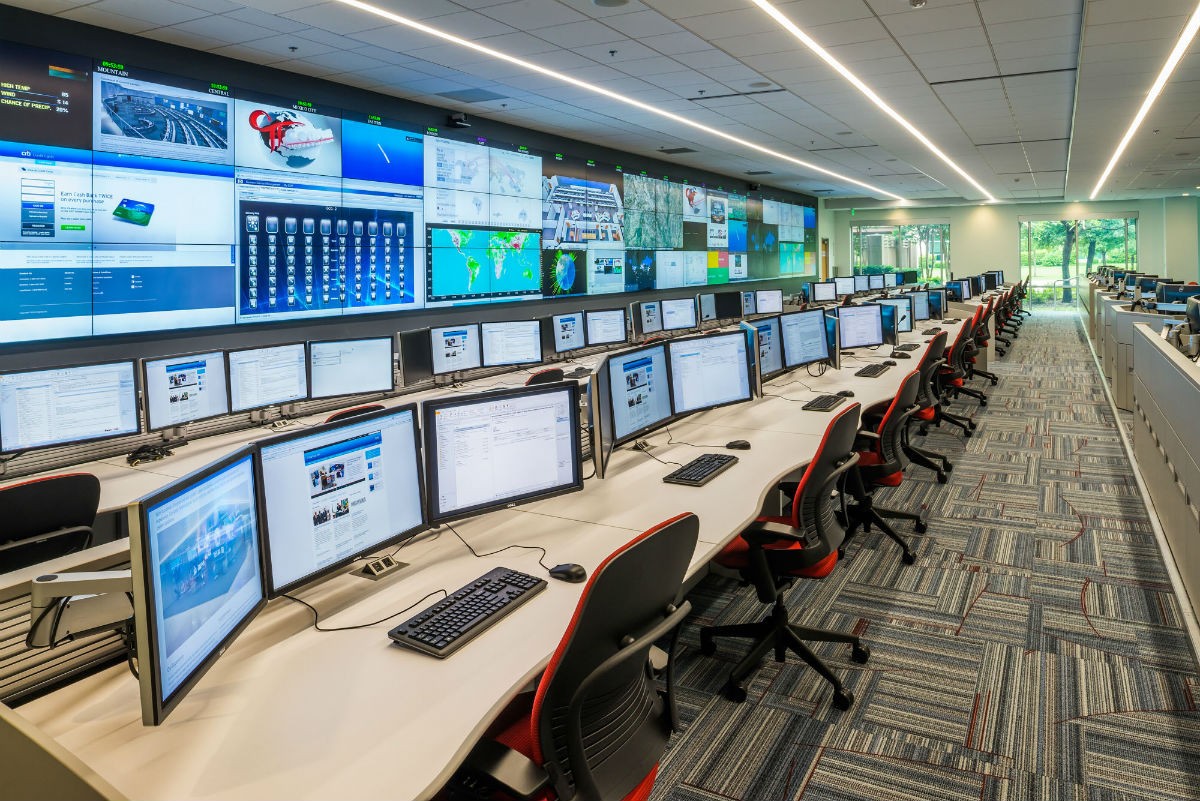Design may not be the first thing you think about when you imagine a 24/7 control center. But if you think design isn’t important in these mission critical spaces, think again.
Freddy Padilla sums it up: in his article on mission critical design solutions that support emergency response published : “The design is as critical as the mission.”
Whether it’s a 9-1-1 call center, which Padilla’s article covers, or another mission critical space such as a network operations center, security operations center, emergency operations center, etc., the design of both the room and of the building itself is vital. These command centers must remain operational at all hours with no interruption. Despite severe weather events or other potential interruptions, they must be reliably running 24/7. Therefore, we design systems with multiple layers of redundancy to ensure there are no failures.
Redundancy
Having extensive safeguards in place is one factor that differentiates mission critical design from that of a regular office space. Redundant power and backup for your data is crucial in mission critical AV integration. Any interruption or potential loss of data could be detrimental to an organization’s operations. In a non-critical office space, the generators and AV technology will not perform in the same manner. For example, generators in a regular office decrease output or turn off to conserve power for critical functions when needed. By contrast, in a mission critical space there is always backup utility, with system sequencing designed to endure even the most extreme conditions.
Similar precautions are taken with the video wall in a command and control environment. The operations center video wall displays important real time information that helps operators make critical decisions. This is why it’s important to select mission critical AV integrators who know the best video wall products for a command center application. The display wall should have redundancy incorporated as well. At Constant we create custom-engineered solutions using the best technologies to create redundancy in the video walls. In the case of a display wall processor failure the entire video wall switches automatically to a backup system and alerts the user that there is an error in the system and to contact our support department.
Additionally, the technology chosen for the command center video wall must be durable enough for a 24/7 environment. These video walls turn on and never turn off. Constant Tech partners with on-site contractors during the process of planning adequate power for these systems.
Making Complexity Simple
Another way that design contributes to the function of mission critical centers is turning complex tasks and requirements into simple use cases. As the center of all critical operations, command and control spaces are inherently complex. These rooms require intricate solutions to guarantee that they can endure extreme conditions or critical events. However, they also must simplify operations for the end user. Thankfully, this is one of Constant’s areas of expertise. In an interview with Commercial Integrator, Constant’s president Brad Righi says, “We focus solely on the complexities of making the interfaces simple for our clients.” We take numerous requirements, sources, and use-cases and map out a detailed solution that the user can enact simply.
Testing
Testing is another key component of mission critical design. Because these rooms can’t fail, everything that goes into them needs to work perfectly from the very beginning. Conducting multiple preliminary tests prior to finalizing the project ensures the entire integration runs smoothly from day one. Constant tests the components of your AV rack at our facilities before shipping them out to the installation site. This ensures everything operates as planned.
The key to mission critical design is planning ahead. From testing and redundancy to simplifying use of sources, all the elements are interconnected. Danny Sasseville, VP of Project Engineering at Constant says, “part of our design process is mapping out all the sources, how they will be routed through the processor and how the client wants each source displayed either on the video wall or at the workstation monitors.” This source mapping process also contributes to design decisions such as cable management for workstations and under flooring. The video wall is not just a standalone part of the installation and design, but an interconnected piece of the operation that affects and is affected by all the other individual pieces. By working closely with facilities staff and general contractors on site, Constant ensures that our part of the design and installation aligns perfectly with every other part of your command space.
The design of mission critical control centers is crucial for the communities or organizations that they serve. NOC designers much think of each part in advance and carefully plan to account for 24/7 use. To learn more about Constant Technologies’ detailed design process, contact us today.
About Constant Technologies, Inc. :
Constant Technologies, Inc. is a mission critical systems integrator with experience worldwide. We provide audiovisual integration of 24/7 video walls and custom operations center furniture. Over 30 years of experience give us the knowledge and clearance to work with sensitive environments in both the public and private sectors. Constant designs, installs and services projects of all scopes and sizes. We create solutions with the highest levels of security, aesthetics and functionality in mind. Some of Constant’s installations include: Network Operations Center design, EOC builds, Fusion Centers, Security Operations Centers, Social Media Command Centers, and other command and control environments.


